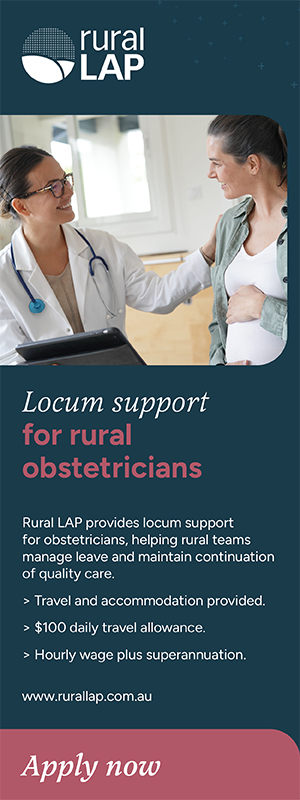Dr Megan Halliday is an Australian O&G whose day to day is slightly different to that of most of her colleagues. Tucked in an isolated hospital set in the middle of nowhere, her team services a 700km-radius area that is sprinkled with 50,000 people. Megan lives in Alice Springs.
About 60 per cent of the pregnant women Megan and her team care for are Aboriginal; a population that is over-represented in several perinatal problems and complications, including stillbirth. Many live far away from the hospital, making problems very hard to manage.
’The only way we can manage diabetes, for instance, is with metformin and insulin. But how do you do this when your patients do not have a functioning fridge? When they live in overcrowded accommodation and children might have access to the needles? Where they can’t come to the hospital because buses do not service where they live? I mean, there’s even a logistics issue regarding how to get fresh food to these communities. We might push the “healthy lifestyle” message all that we want to, but the economic reality of our patients is different. And it has a direct impact on what we can do.’
Megan’s team works closely with independent Aboriginal services, trying to keep women in their community as much as possible by using telehealth on a weekly basis. The team also holds a regular outreach service in which they fly to isolated communities to hold face-to-face consultations. However, on top of struggling with the impact of all health problems of her patients, Megan also struggles with another important challenge: attracting colleagues to the area.
With no regular registrar rotations in place, as of today, the O&G hospital staff comprises five specialists: three overseas trained specialists, one locally trained GP obstetrician, and Megan. She speaks highly of her international colleagues, who have come with an open mind and who have taken on the challenge of understanding cultural differences in Central Australia.
’If it wasn’t for overseas-trained doctors we wouldn’t have services in regional Australia. One of my colleagues, Dr Lakshmi, has hopped into the small planes to do regular community visits for the past 16 years. Central Australia is not an easy environment for foreign doctors to adapt to on top of the hassles involved in coming to a different country, and yet, they’re often the only ones that are willing to come here.’
Megan would like to see Australian and Aboriginal doctors join the team.
’Most people don’t think about the fact that Aboriginal and Torres Strait Islanders have different priorities and responsibilities. In western culture, it is all about the individual, but for Aboriginal people, they are part of an extended family, so their own health comes second. That can be hard for new people to grapple with. Central Australia requires you to take on a new perspective and to be prepared to adapt. We need more Aboriginal midwives, general practitioners and specialists; people who can understand this, and people who are open to different ways of viewing the world.’



